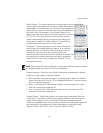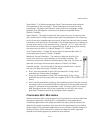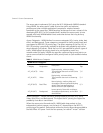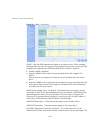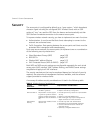
5-46
CHAPTER 5: SYSTEM CONFIGURATION
The access point implements QoS using the Wi-Fi Multimedia (WMM) standard.
Using WMM, the access point is able to prioritize traffic and optimize
performance when multiple applications compete for wireless network
bandwidth at the same time. WMM employs techniques that are a subset of the
developing IEEE 802.11e QoS standard and it enables the access point to inter
operate with both WMMenabled clients and other devices that may lack any
WMM functionality.
Access Categories – WMM defines four access categories (ACs): voice, video, best
effort, and background. These categories correspond to traffic priority levels and
are mapped to IEEE 802.1D priority tags. The direct mapping of the four ACs to
802.1D priorities is specifically intended to facilitate inter operability with other
wired network QoS policies. While the four ACs are specified for specific types of
traffic, WMM allows the priority levels to be configured to match any
network-wide QoS policy. WMM also specifies a protocol that access points can
use to communicate the configured traffic priority levels to QoS-enabled wireless
clients.
Table 3 WMM Access Categories
WMM Operation – WMM uses traffic priority based on the four ACs; Voice,
Video, Best Effort, and Background. The higher the AC priority, the higher the
probability that data is transmitted.
When the access point forwards traffic, WMM adds data packets to four
independent transmit queues, one for each AC, depending on the 802.1D
priority tag of the packet. Data packets without a priority tag are always added to
the Best Effort AC queue. From the four queues, an internal “virtual” collision
WMM Access Categories
Access
Category
WMM
Designation
Description
802.1D
Tags
AC_VO (AC3) Voice
Highest priority, minimum delay.
Time-sensitive data such as VoIP (Voice
over IP) calls.
7, 6
AC_VI (AC2) Video
High priority, minimum delay.
Time-sensitive data such as streaming
video.
5, 4
AC_BE (AC0) Best Effort
Normal priority, medium delay and
throughput. Data only affected by long
delays. Data from applications or
devices that lack QoS capabilities.
0, 3
AC_BK (AC1) Background
Lowest priority. Data with no delay or
throughput requirements, such as bulk
data transfers.
2, 1






